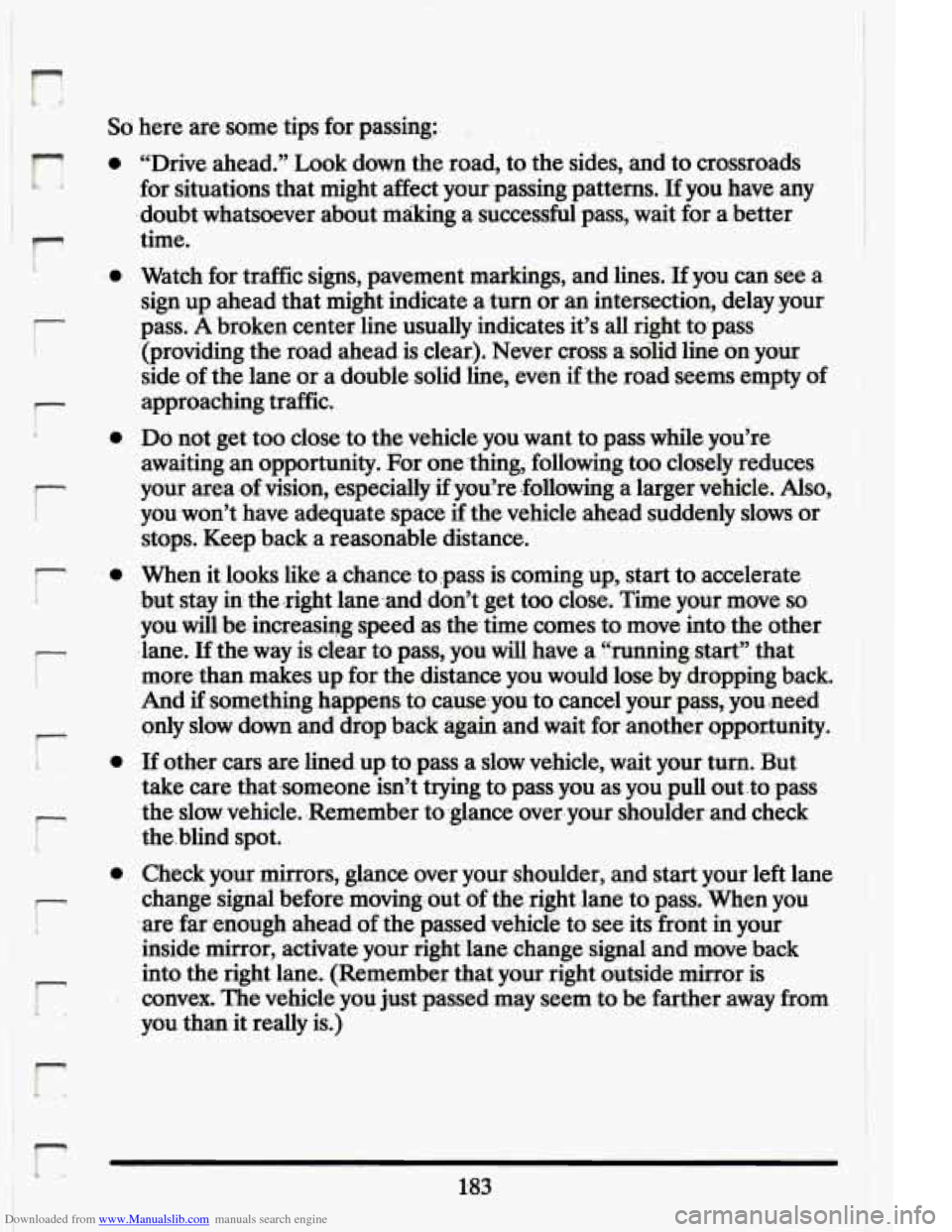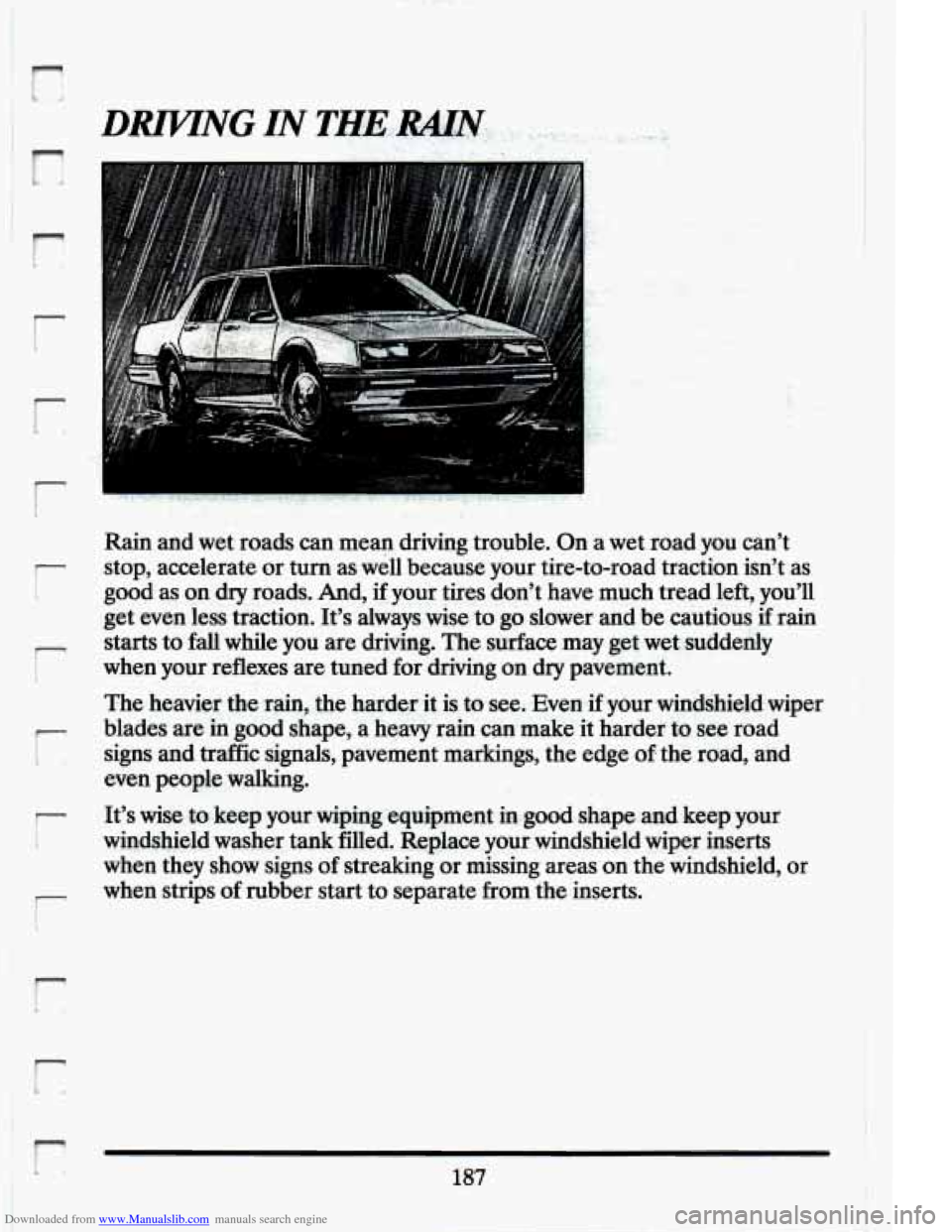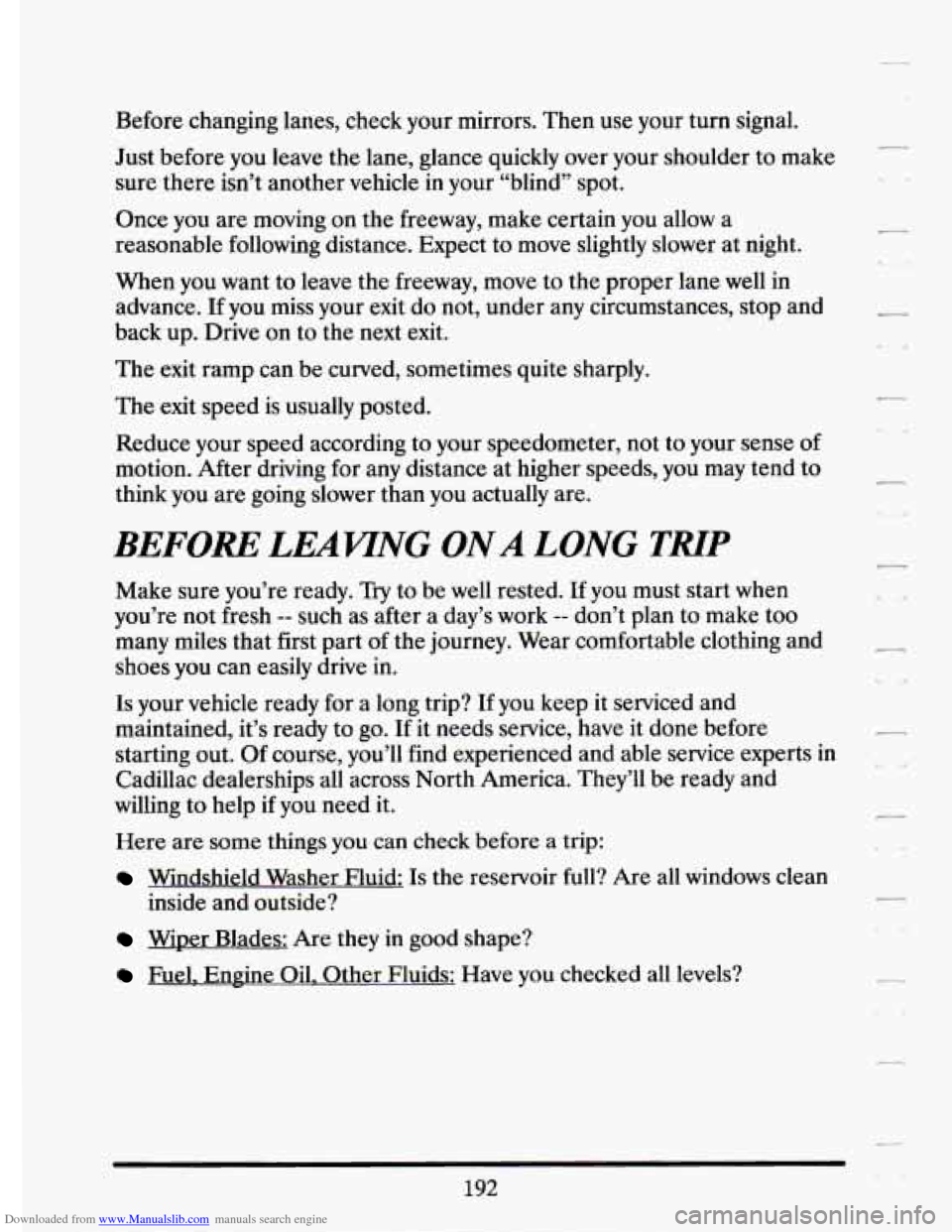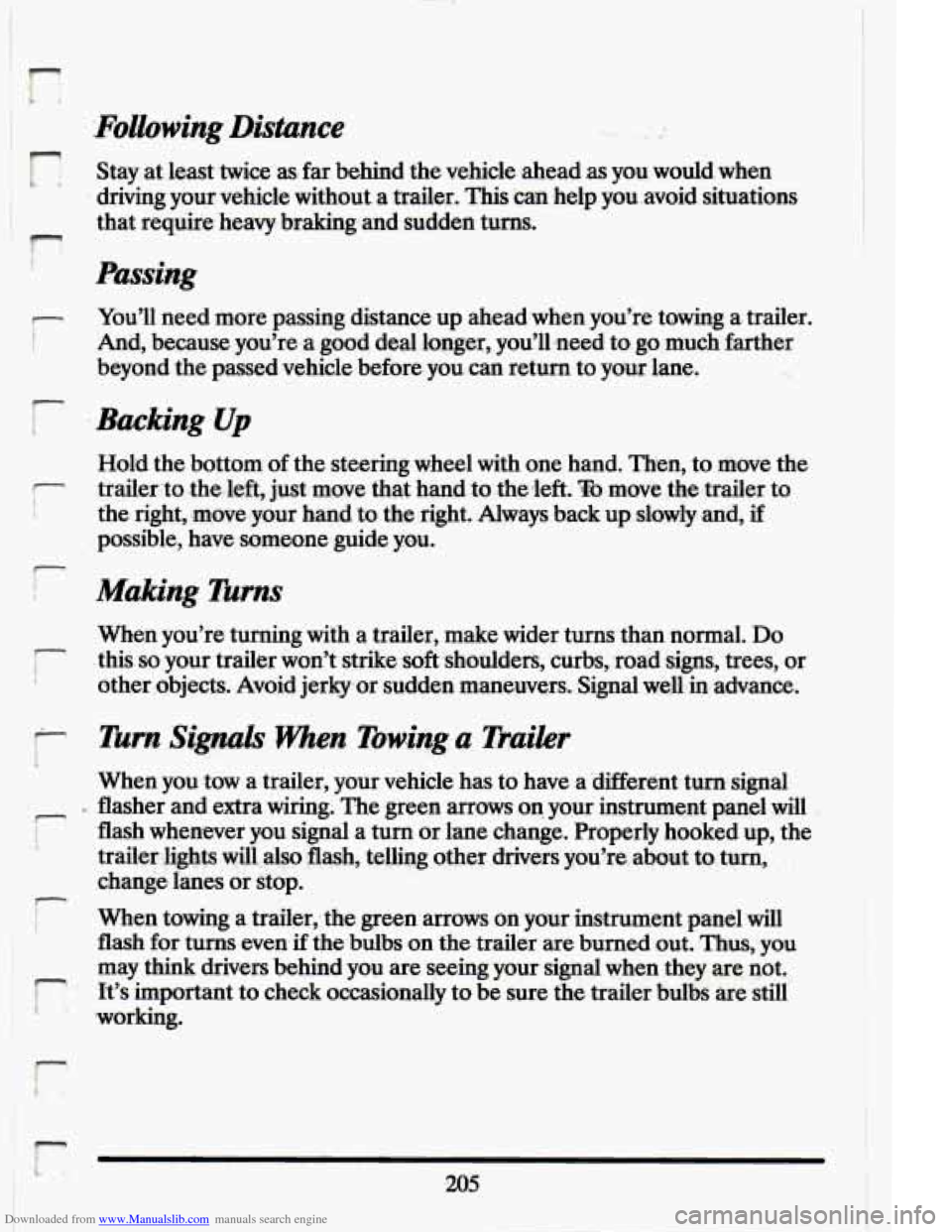Page 180 of 398
Downloaded from www.Manualslib.com manuals search engine Be sure never to touch
the signal surface when
handling discs. Pick
up
discs by grasping the
outer edges or the
edge
of the hole and
the outer edge.
I
Power Antenna Mast Care
Your power antenna will look its best and work well if it’s cleaned from
time to time.
To Clean the Antenna Mast:
1. Turn on the ignition and radio to raise the antenna to full mast
2. Dampen a clean cloth with mineral spirits or equivalent solvent.
extension.
3. Wipe cloth over
the mast sections, removing any dirt.
4. Wipe dry with clean cloth before retracting.
5. Make the antenna go up and down by turning the radio or ignition on
and
off.
6. Then repeat if necessary.
168
r
.
Page 195 of 398

Downloaded from www.Manualslib.com manuals search engine So here are some tips for passing: . .
r I
r
0
0
0
0
r
F
0
F i
0
c
r
“Drive. ahead.” Look down the road, to the sides, and to crossroads
.for situations that might affect your passing patterns.
If you have any
doubt ,whatsoever about making a successful. pass, wait for a.better
time.
.Watch- for traffic signs, pavement markings, and lines.
’If you can see .a
sign up ahead that might indicate a turn or an intersection, delay your
pass.
A broken center line usually .indicates it’s all right to pass
‘(providing the road ahead isclear.):Never cross
a solid line on your
side
of the lane or a double solid line, even if ‘the road. seems empty of
approaching traffic.
Do not :get
too closelo the,vehicle you want.to pass while you’re
awaiting- an opportunity. For .one lthmg, following too closely reduces
your
area ,of vision, especially if you’re .following a ‘larger vehicle. Also,
you-won’t have adequate space if the vehicle ahe:ad suddenly slows or
stops. Keep back a reasonable distance.
When it looks like a .chance: to ,pass
is coming. up, start to. accelerate
.but stay in the.right 1ane.and.don’t.get too dose. Time your move
so
.you wiIl.be .increasing speed as the time comes to move into the other
.lane.
If the way is clear to pass, you will have a .‘‘running, start” that
more than makes up for the distance you would lose
by .dropping back.
And
if something happensto.cause:youto cancel your pass, you need I
only slow down and drop back again and wait for another opportunity.
-If other cars are 1ined.u~ to pass a slow vehicle, wait your turn. But
take care that someone isn’t trying
to pass you as you:,pull outto pass
the slow vehicle. -Remember
to ‘glance over. your shoulder-and check
theblind spot.
Check your mirrors, glance over your shoulder, and start your left lane
change signal before moving.out
of the right .lane to pass,. When you
:are far:enough ahead
of ,the passed vehicle to see its front in. your
inside mirror, activate your right. lane change signal
and move back I
into the right lane. (Remember that your right outside mirror is
convex.
The vehicle you just passed may seem to be farther away from
you than itreally is.)
!,, 1 - ’ - ,- . ..
183
Page 199 of 398

Downloaded from www.Manualslib.com manuals search engine r
i
r
r
r
I
I
Rain and wet roads can mean driving trouble. On a wet road you can’t
stop, accelerate or turn as well because your tire-to-road traction isn’t .as
good as on dry roads. And,
if your tires don’t have much tread left, you’ll
get even less traction. It’s always wise to go slower and be cautious
if rain
starts to fall while you are driving. The surface may get wet suddenly
when your reflexes are tuned for driving on dry pavement.
The heavier the rain, the ha&r it is to see. ,Even if your windshield. wiper
blades are ‘in good shape, a heavy rain can make it harder to see road
signs and traffic signals, pavement markings, the edge
of the road, and
even people walking.
It’s
wise to. keep yourwiping -equipment,in.good shape ,and keep your
windshield washer tank filled. Replace your windshield wiper inserts
when they show signs
of streaking or missing areas on the windshield, or
when strips of rubber start
to separate from the inserts.
Page 202 of 398
Downloaded from www.Manualslib.com manuals search engine CITYDRZWNG
One of the biggest problems with city streets is the amount of traffic on
them. You’ll want to watch out for what the other drivers are doing and
pay attention to traffic signals.
Here are ways to increase your safety in city driving:
0
0
0
Know the best way to get to where you are going. Get a city map and
plan your trip into an unknown part
of the city just as you would for a
cross-country trip.
Try
to use the freeways that rim and crisscross most large cities. You’ll
save time and energy. (See the next section, “Freeway Driving.”) 7-
Treat a green light as a warning signal. A traffic light is there because
the comer is busy enough to need it. When a light turns green, and
just before you start to move, check both ways
for vehicles that have
not cleared the intersection or may be running the red light.
Page 204 of 398

Downloaded from www.Manualslib.com manuals search engine Before changing lanes, check your mirrors. Then use your turn signal.
Just before you leave the lane, glance quickly over your shoulder to make
sure there isn’t another vehicle
in your “blind” spot.
Once you are moving
on the freeway, make certain you allow .a
reasonable following distance. Expect to move slightly slower at night.
When you want to leave the freeway, move to the proper lane well
in
advance. If you miss your exit do not, under any circumstances, stop and
back up. Drive
on to the next exit.
The exit ramp can be-curved, sometimes quite sharply.
The exit speed is usually posted.
Reduce your speed according to your speedometer, not
to your sense of
motion. After driving for any distance at higher speeds, you may tend to
think you are going slower than you actually are.
BEFORE LEAVTNG ONA LONG THP
Make sure you’re ready. Try to be well rested. If you must start when
you’re not fresh
-- such as after a day’s work -- don’t plan to make too
many miles that first part of the journey. Wear comfortable clothing and
shoes you can easily drive in.
Is your vehicle ready for a long trip? If you keep it serviced and
maintained, it’s ready to go. If it needs service, have it done before
-
starting out. Of course, you’ll find experienced and able service experts in
Cadillac dealerships all across North America. They’ll be ready and
willing to help
if you need it.
Here are some things
you can check before a trip:
Windshield Washer Fluid: Is the reservoir full? Are all windows clean
inside and outside?
Wiper Blades: Are they in good,shape?
Fuel, Engine Oil. Other Fluids: Have you checked all levels?
-.
192
Page 217 of 398

Downloaded from www.Manualslib.com manuals search engine n
F- I
r
r i
I r’ j’ IL i
Folbwing Distance ~ ..
Stay at Least ,twice as far behind the vehicle ahead as you would when
driving your vehicie without a trailer.
This can help you.avoid situations
that require heavy braking and sudden turns.
,Passing
You’ll need more passing distance up ahead-.when you’re towing a. trailer.
And, because y0u’re.a good deal longer, you’ll need to go much farther
beyond the passed vehicle before you .can return to
your lane.
Backing Up
Hold the bottom of the steering wheel with one hand. Then, to move the
trailer ‘to .the- left, just move that hand
to the left. To move the trailer to
the right, .move -your hand
‘to the right. Always back up. slowly and, if
possible, have someone guide you.
Making nrns
When you’re turning with a trailer, make wider turns than normal. Do
.this so your trailer won? strike soft shoulders, curbs, road signs, trees, or
other .objects. Avoid jerky.or sudden maneuvers. Signal well
in advance.
Turn sigreals When Towing a Trailer
When you tow a trailer, your vehicle has to have a different turn signal
.= flasher and extra wiring. The green arrows on your instrument panel will f
J I flash, whenever you signal a turn or lane change. Properly hooked. up, the
trailer
l&hts will also flash, telling other drivers you’re about to turn,
change lanes or stop.
flash for turns even’if the.bulbs on the trailer are burned out. .Thus, you
may think drivers behind
you are seeing your- signal when they are not.
’ Et’s important to check occasionally to be sure the trailer. bulbs are still
r
i When towing a trailer; the green arrows on your instrument panel will
t! working.
205
Page 221 of 398
Downloaded from www.Manualslib.com manuals search engine P
h .4
r
Your hazard warning flashers let you warn others. They also let police
know you have a problem. Your front and rear turn signal lights will f\
lash
on and off.
t T
Press the button into make your front and rear turn signal lights flash on
and
off.
209
Page 222 of 398
Downloaded from www.Manualslib.com manuals search engine The light on your instrument panel will flash indicating that the hazard
warning flashers
are on.
Your hazard warning flashers work no matter what position your
key is in,
and even
if the key isn’t in.
OTHER WMING DEWCES
To turn off the
flashers, pull out on
the collar. When the
hazard warning
flashers
are on, your
turn signals won’t
work.
If you carry reflective triangles, you can set one up at the side of the road
about 300 feet (100 m) behind your vehicle.
210